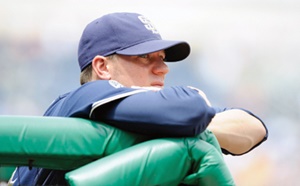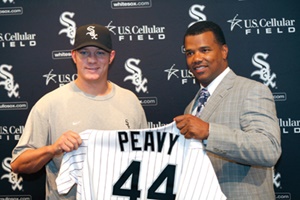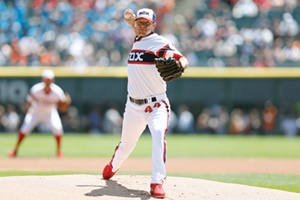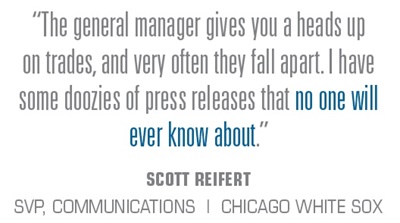As Major League Baseball’s annual nonwaiver trade deadline nears this week, a front-office executive’s routine trip through his team’s clubhouse can become anything but routine.
“Starting around the last two weeks of July, it gets quieter when I come through the clubhouse,” said Chicago White Sox general manager Rick Hahn.
It’s a feeling that runs through big-contract, high-impact veterans and low-dollar, throw-in prospects. They all know what the July 31 deadline can bring: a new uniform, a new ballpark — a new home. For some, it’s a case of being sprung out of the drudgery of last place and into the heat of a pennant race. For others, the ones going the opposite way in the deal, it’s the reverse.
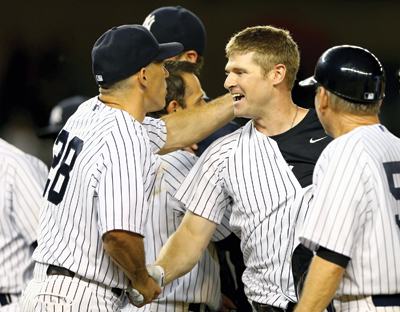 |
|
Chase Headley had a game-winning hit for the Yankees a few hours after walking into their clubhouse for the first time.
Photo by: GETTY IMAGES
|
Chase Headley was one of the first to experience the jolt this year.
On Tuesday, the former San Diego Padres veteran was told of his trade to the New York Yankees, arrived in New York’s LaGuardia Airport at 6:30 p.m. from Chicago, where the Padres had been, got to Yankee Stadium shortly after the first pitch, introduced himself to his new teammates in the dugout, and then delivered the walkoff, game-winning hit for the Yankees in an extra-inning victory over Texas.
Beyond the on-field dramatics, though, it takes a well-choreographed, behind-the-scenes effort to send a player overnight (or on the same day) to a new team perhaps a coast away.
Sometimes a player sees the trade coming; other times he doesn’t. Either way, the traded player quickly becomes friends with each team’s traveling secretary. Far more functional than the comedic take offered on “Seinfeld,” the traveling secretary is the one who makes the arrangements to get players into town and integrated into their new work setting.
 |
Tuliebitz
|
“Certainly at this time of year, we’re always sensitive to the fact that things can happen very quickly and we have to be ready to react,” said Ben Tuliebitz, Yankees director of team travel and player services. “In the case of Chase, we were very fortunate that the Padres were already in Chicago, and there’s a flight leaving O’Hare for New York basically every hour.”
The Yankees and Padres worked on the Headley trade off and on for about three weeks, and Headley had been aware he was the subject of trade rumors. A similar situation occurred last year with pitcher Jake Peavy, who was sent by the fading Chicago White Sox to the contending Boston Red Sox in a three-team swap that also involved the Detroit Tigers.
Peavy had been through a trade-deadline deal before: He came to Chicago from San Diego in a deal on July 31, 2009. He might find himself on the move again this year. His name was swirling last week as a trade target, so Peavy likely will do as he did in Chicago last summer, when he had his apartment packed up days before the deadline in order to expedite any move out of town.
Because of his veteran status, Hahn kept Peavy steadily informed of his trade negotiations last year. It wasn’t a question of when Peavy would be moved — simply one of where.
“Jake had been here for a long time and was comfortable coming into our office to sit down and ask for a sense of the likelihood of being moved and the handful of clubs that would be interested,” Hahn said.
That type of courtesy is reserved particularly for veterans with no-trade clauses in their contracts or those who hold “10-5” rights after playing 10 years in the majors and five years with their current club, a standing that allows them to block any trade. That was the situation pitcher Ryan Dempster found himself in two years ago. The then-Chicago Cubs pitcher sat in the Cubs’ offices playing the video game Golden Tee while general
manager Jed Hoyer feverishly worked the phones at deadline trying to move him. As the 3 p.m. CT deadline neared, Dempster took a break from Golden Tee to approve a last-minute deal with the Texas Rangers.
But even as many veterans are kept apprised of potential trades, having such a front-row seat to the trade process as Dempster did is much more the exception than the rule. Most teams treat trade negotiations as highly covert
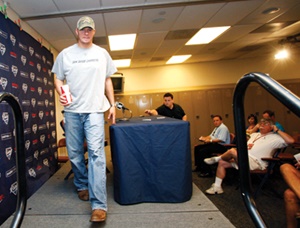 |
|
Jake Peavy is a trade deadline veteran. In 2009, he was a Padre until his trade to the White Sox on July 31 …
Photos by: GETTY IMAGES (2); AP IMAGES
|
operations.
“In most situations, it isn’t feasible,” Hahn said of involving a player directly in the trade process. “We find it much easier to do our business without public scrutiny. Information could lead to other clubs jumping in, or a team to get cold feet. We keep it as quiet as possible and keep it out of the clubhouse.”
Both teams’ media relations staffs are also closely involved.
Typically, as the two general managers get close to an agreement, the teams’ media departments are alerted in order to begin working on the press releases that will be needed to announce the deal. Once the trade is completed, those staffs work to coordinate what the announcement time will be for both teams. They then finalize the press releases, prep the necessary social media, and ultimately alert both the local and national media to the trade at the agreed-upon announcement time. Then comes a scheduled media conference call or media availability with the acquiring team’s general manager and the newly acquired player. Sometimes this happens within an hour or so, sometimes the next day.
Sometimes, the new player meets the media for the first time in the dugout or clubhouse once he arrives.
It’s often never as smooth as it seems.
“When we acquired Jose Contreras in 2004, it was 15 minutes from the deadline and there had been nothing; no dialogue, no conversation, and we figured we didn’t make a deal,” said Scott Reifert, senior vice president of communications for the White Sox. “Then all of a sudden, the phone rings, and we have the trade and the approval from the commissioner’s office all within a span of 15 minutes. It was amazing to watch that and then scramble to coordinate the announcement.”
Reifert also has a number of draft press releases announcing trades that were never made.
“The general manager gives you a heads up on trades and very often they fall apart,” Reifert said. “I have some doozies of press releases that no one will ever know about.”
■ ■ ■
When Hahn dealt Peavy last year, the veteran right-hander was in Boston within a matter of hours, thanks in part to Ed Cassin, White Sox director of team travel, who made a battery of calls to get the Red Sox their newly acquired pitcher as soon as possible to begin the acclimation into the middle of a pennant race.
Cassin’s first call was to his Red Sox counterpart, Jack McCormick, to brief the club not only on moving logistics but also to give McCormick a sense of the player Boston had just acquired in order to help smooth the transition.
“Just a few questions about Jake and what kind of guy he is,” Cassin said.
Cassin also did the Red Sox a professional courtesy by immediately arranging Peavy’s flight to Boston that night, even though it is the acquiring team’s financial responsibility to get the new player to town.
“We talk all the time,” Cassin said of his familiarity with his traveling secretary
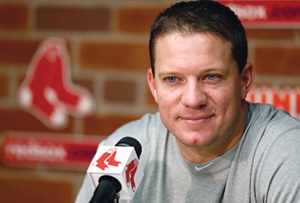 |
|
… and then he did the quick-change again last season, when the fading White Sox dealt him to the contending Red Sox.
Photos by: GETTY IMAGES (2)
|
fraternity. “We’re all in the same boat.”
Guided by provisions in MLB’s collective-bargaining agreement, Cassin immediately booked a first-class airline ticket for Peavy on the first available flight, and then billed the Red Sox for the cost.
The players’ agents also are frequently involved in the post-trade logistics, including helping settle personal affairs in the departed city.
“It depends on the player and the situation, but usually we coordinate with the front office, more often the GM or assistant GM rather than the traveling secretary, to make sure that travel arrangements work for our client and to safeguard his rights,” said Greg Genske, a veteran baseball player agent who is executive director of The Legacy Agency and president of its baseball practice.
The CBA allows a player 72 hours to report to a new city, but unless it’s a disgruntled player being sent to the minors, unofficial baseball custom generally calls for the traded player to be in his new uniform that night or the next day.
The acquiring team pays for seven days of hotel housing for the traded player, picking up any outstanding lease payments on the player’s housing in his prior city for the duration of that season, and arranging to ship the player’s car to the new city. After the seven days of hotel housing ends, it is up to the player to handle his own accommodations. Teams often assist with recommendations of local real estate brokers, but some clubs stop short of making any specific housing arrangements for the new player.
“I have a list of Realtors we have used over the years that are baseball friendly,” Cassin said. “But I don’t personally set any housing up. I want the player to feel confident about their pick and I don’t want to be the one in the middle.”
Those housing discussions, however, will vary widely depending on whether the player is a prospect or veteran, whether he’s played in the new market earlier in his career, and whether he’s under a long-term contract or will be a free agent following the season.
“Those kind of conversations really can vary,” Tuliebitz said. “When we got [second baseman Alfonso] Soriano just before deadline last year, he had already been here, and knew what he wanted to do. Another player who’s new and only might be here the rest of the season might just say, ‘I’m just going to stay at a hotel.’”
When the newly acquired player shows up in his new team’s clubhouse, he will find his new uniform hanging in his locker and will get an early visit from the general manager.
“That first day is a whirlwind in meeting me and the coaches and the PR people and just letting them know they can reach out for any assistance to help get settled,” Hahn said. “Many of these guys have been through it before and know what it entails. We just try to make it as easy as possible off the field.”
Tuliebitz agreed.
“[Tuesday] was kind of crazy all the way around, but once things settle down over the next day or so, I’ll have a chance to sit down with Chase and figure out what his housing options are,” he said. “We try to be a full-service operation here.”
Staff writer Liz Mullen contributed to this report.




